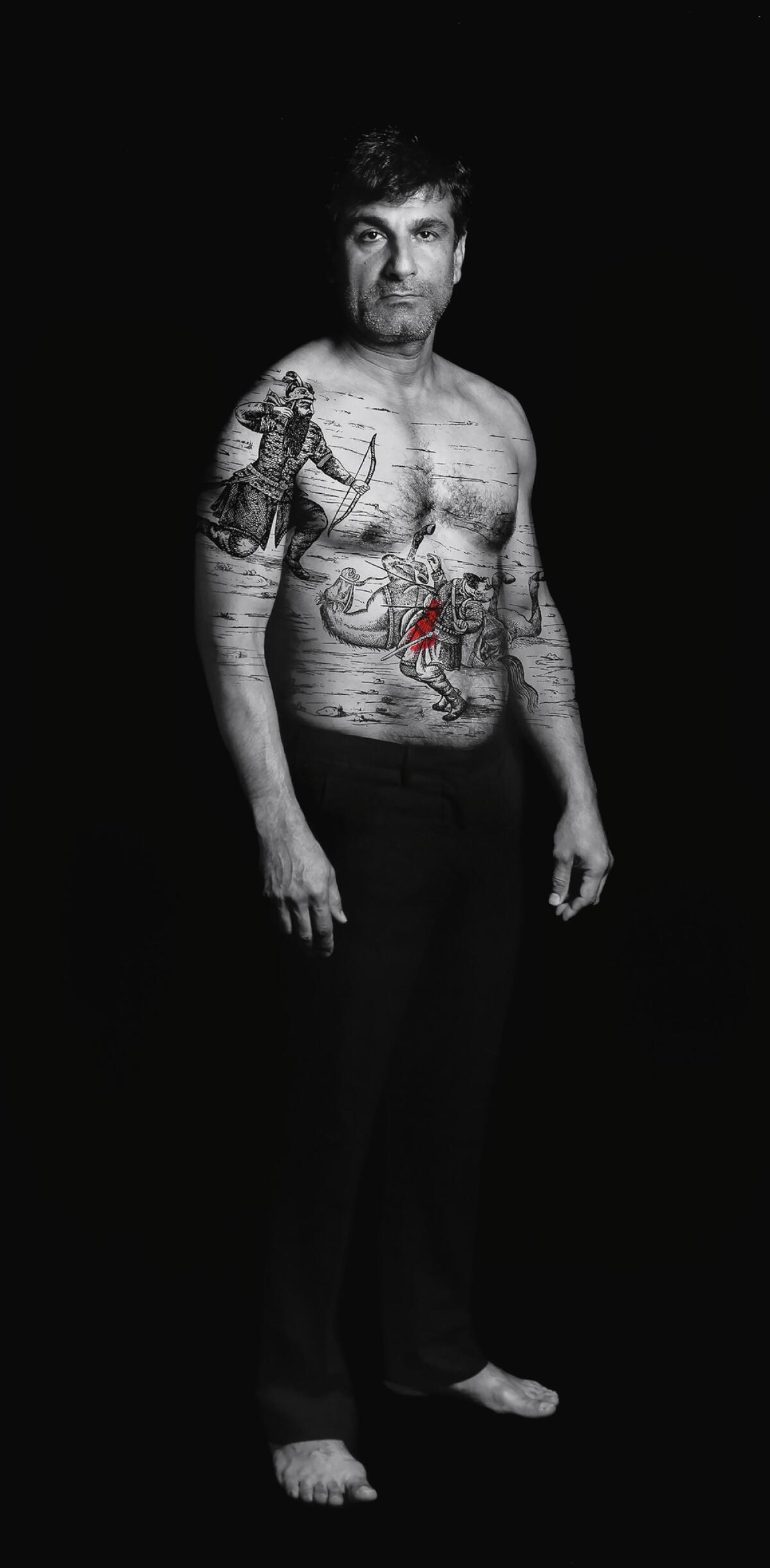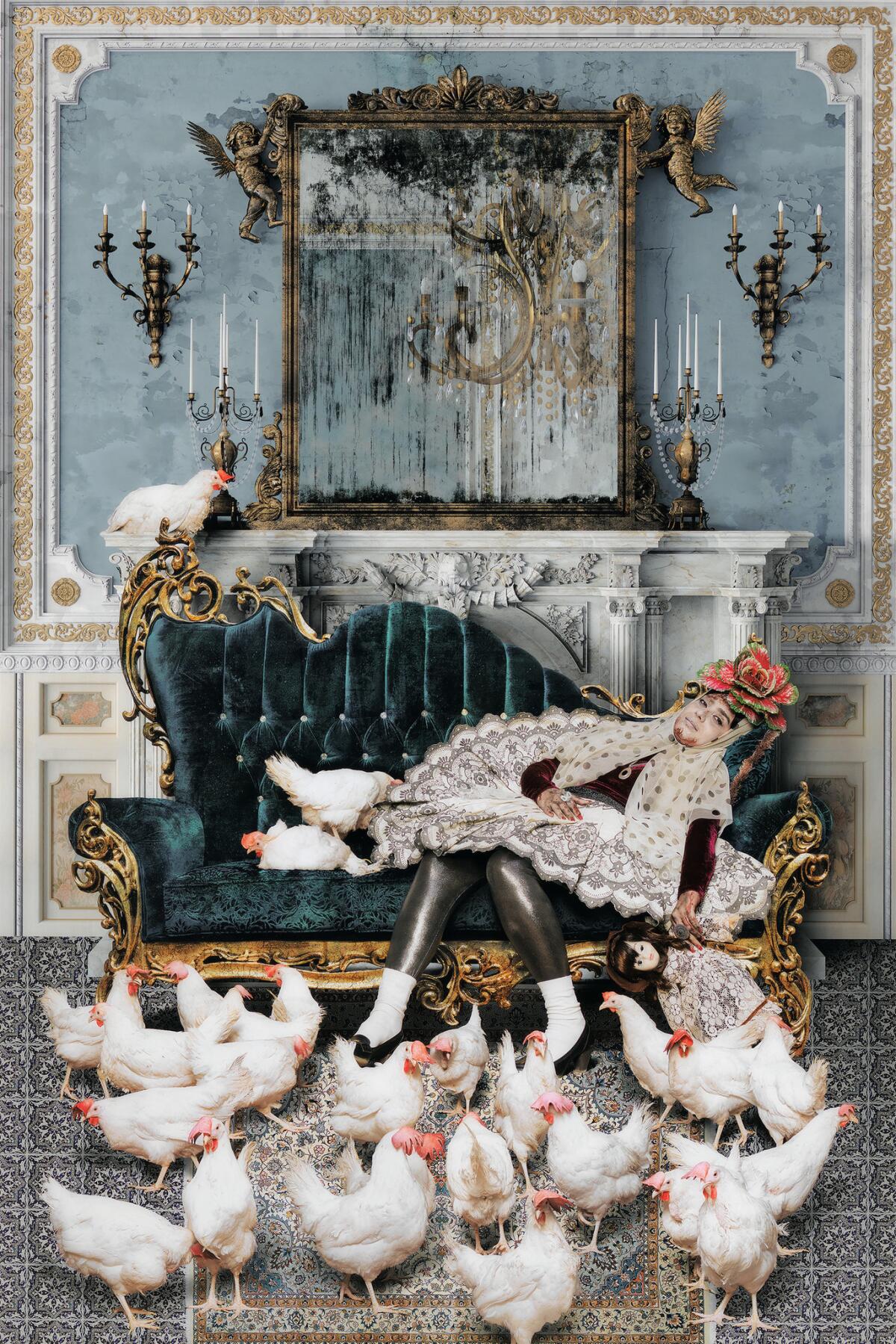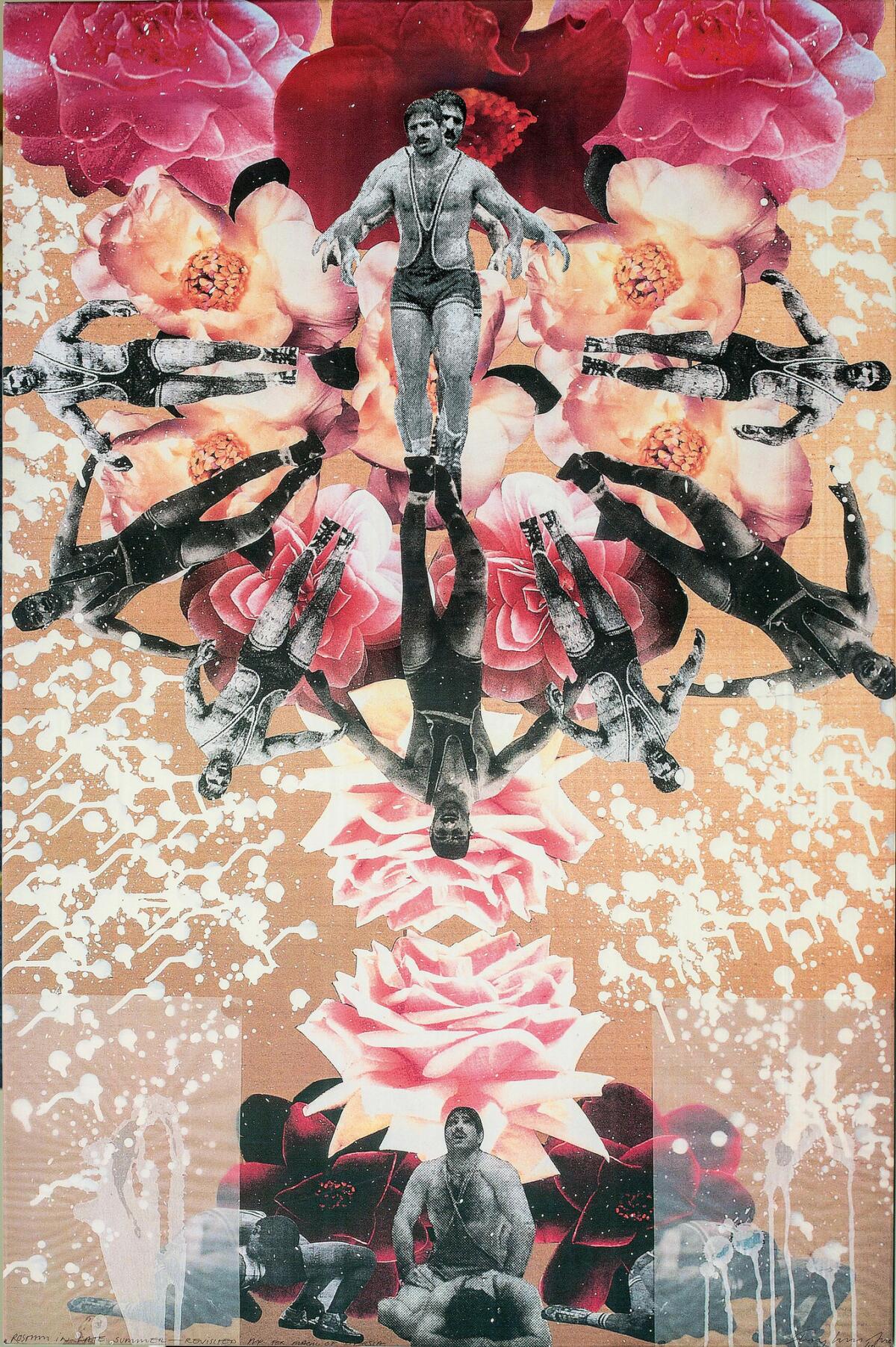Review: In Iranian art show at LACMA, the past wrestles with the present
If a country’s mammoth national epic traces the larger-than-life dynastic rivalry and grinding frictions of 50 historic kingdoms, all to unify a sprawling region into a single, functional whole, you can bet those stories will be pictured in its art.
So it has been in Iran – for centuries.
The “Shahnama,” or Book of Kings, is 50,000 rhyming couplets recounting three successive dynasties leading to the Arab conquest of Persia; the book was finished four centuries later, around AD 1010. Its ethos is a swirling fusion of fact and fiction.
The artistic imagery, however, isn’t always what one might expect, as a big exhibition at the Los Angeles County Museum of Art attests. Much, though not all, of the art refers to the epic. Early on in “In the Fields of Empty Days: The Intersection of Past and Present in Iranian Art,” which features 125 works by more than 50 artists, large-scale photographs show black line-drawings of exploits by the heroic warrior Rustam superimposed onto the undraped bodies of anonymous men.
Shirin Neshat, the best known artist in the Iranian diaspora, borrowed the line-drawings from historical lithographs illustrating the “Shahnama.” (The exhibition’s title is taken from it.) Her superimposition of the drawings onto the men transformed the historical pictures into virtual tattoos, etched permanently into her sitters’ vulnerable skin.
A sense that something might not be quite right is most keenly felt in her photograph “Divine Rebellion.”
A larger-than-life pair of legs, shown from the toes up to just before the knees, fills the frame. Drawn on them are pictures of mounted medieval armies facing off, while in the foreground an archer wrapped around the right shin has let fly an arrow, which seems to have hit its mark on the left shin. There, red blood gushes from a black-and-white warrior’s torso.
What’s disconcerting, though, is not the warfare. It’s the relationship between that horror and the position of the feet.
Neshat printed the photograph against a pitch-black background, so no location for the bodily fragment is in evidence. One foot seems relatively at rest; the other has a slightly elevated heel. The unidentifiable figure, an Iranian Everyman, seems about to take a cautious step forward — or, more sinisterly, dangles suspended in space.
Hanged, in short.

Two other photographs show men, one middle-aged and the other elderly, both barefoot and stripped to the waist. The same “Divine Rebellion” battle-drawings are superimposed over their torsos, although these figures are identified in the titles as “villains.”
Neshat posed them wearing jet-black pants, which blend seamlessly with the black backgrounds. The men are sinking into or emerging from an encompassing void.
Likewise, the black battle-drawings on their bodies seem to ooze into (or maybe from) the surrounding darkness. Neshat’s photographs are compelling because of their haunted ambiguity.
The Persian mythologies in the ancient Book of Kings, where heroes vanquish enemies both human and supernatural, are proposed as both a blessing and a curse — at least for the male population of contemporary Iran. The cultural tattoos cloak individual anonymity with a national identity, yet they also inescapably imprison, scar and even destroy.
Tattoos also turn up in several other works — by Bahman Jalali, Khosrow Hassanzadeh, Kaveh Golestan, Abbas, Siamak Filizadeh and Fereydoun Ave — where they typically mark the powerful bodies of wrestlers. Iranian wrestling is essentially a Persian version of baseball — Iran’s national pastime, an athletic ritual celebrated as an almost chivalrous mechanism for building character.
The drawback is that almost all of these photographs, collages and mixed media works are visually dull. Some seem merely celebratory, others wanly satirical (in one, the “Shahnama” hero Rustam is done up as a wrestler merged with celebrity movie characters like Conan the Barbarian or Rambo). Still others are blandly ruminative, as in Ave’s bleak image of an Olympic gold medal champion transposed into a wintry landscape.


Too much of the show is like that — topically insular and unengaging. Almost half the works are drawn from the museum’s permanent collection, a broad range that includes luxurious Safavid manuscript illuminations from the 16th and 17th centuries through documentary photographs, carpets and videos from the last 25 years.
Curator Linda Komaroff elected not to provide didactic wall texts or object labels, banking on the art to explain as much of itself as it could. The decision doesn’t really succeed.
Informational iPads and a catalog are available in a separate room. But, absent a cursory knowledge of a thousand years of Middle East history, a viewer can feel adrift. Even Arabic texts embedded within art objects go mostly untranslated, despite the integral nature of their content and graphic design.
The most successful aspect is the integration of objects from sometimes vastly different eras, past and present, in which it is not difficult to identify a repetition in the cast of characters.
A pair of mid-20th century paintings of Rustam attributed to Hussein Qular Aqasi, for example, hangs just inside the entry. Their affectless, hierarchical combatants — they look like carved reliefs from ancient Persepolis — set you up to connect with Neshat’s “tattoo photographs” later on in the show. A depth of cultural mythology and historical continuity is implied, if not fleshed out.
Perhaps the primary problem is a confusion over art history, spelled out in the catalog. Rejecting linear history — a traditional viewpoint in which the past leads to the present — the show instead considers the present to be an accessible frame through which the past can be understood.
I suspect that presuming that the art of the present is easily, universally appreciated will come as a surprise to many. Sometimes that makes sense, but not always. And even though all art is always experienced in the present, whether the object was made last week or in the 16th century, often that experience is as mysterious and remote as the ancient history of a lost world. Why favor one over the other?
The show is divided into two themes, one mortal and the other divine. Sometimes the themes overlap.
“Kings and Heroes” can incorporate the legendary Rustam — a virtual Iranian superhero, right down to the magical suit he wore, impervious to all sorts of weaponry — and Mohammad Reza Shah Pahlavi, overthrown in the 1979 revolution and rather less impervious.
“Saints and Martyrs” includes Asad Faulwell’s tall, 2009 painting of a wobbly column erected from recent religious and political figures, plus an exquisitely drawn, chromatically brilliant small sheet from a manuscript, painted around 1530-35, that shows flaming golden halos around the family of the prophet Muhammad.
New York artist Shoja Azari distills the sweep of these elements in two video projections, inserting live-action clips of recent political events into a Persian manuscript painting and a coffee-house mural. (Azari sometimes collaborates with Neshat; the two will speak with composer Mohsen Namjoo at the Getty on Monday, and Neshat appears at the UCLA Hammer Museum the following night.) Similarly, Filizadeh’s inkjet photo-prints of lavish if often inscrutable costume-dramas, often starring himself as static protagonist of the historical epic, makes him Tehran’s Eleanor Antin.
I couldn’t make heads nor tails of many of Filizadeh’s visual stories, though. The most compelling is perhaps the simplest, showing an overdressed royal personage indolently reclining on a velvet couch in a palatial chamber. Surrounded by a flock of pecking chickens, the fantastic mystery queen becomes a down-home barnyard ruler.
I looked her up later. A Cinderella story, like hundreds of others told around the world throughout history, it would have been good to know while in the exhibition.
♦ ♦ ♦ ♦ ♦ ♦ ♦ ♦ ♦ ♦
‘In the Fields of Empty Days: The Intersection of Past and Present in Iranian Art’
Where: LACMA, 5905 Wilshire Blvd., L.A.
When: Through Sept. 9; closed Wednesdays
Info: (323) 857-6000, www.lacma.org
christopher.knight@latimes.com
Twitter: @KnightLAT
MORE ART:
Thom Mayne design unveiled for future home of Orange County Museum of Art
Deborah Roberts' powerful statement of black female identity
MOCA has lacked an effective director for nearly 20 years. It's time for change
The biggest entertainment stories
Get our big stories about Hollywood, film, television, music, arts, culture and more right in your inbox as soon as they publish.
You may occasionally receive promotional content from the Los Angeles Times.








